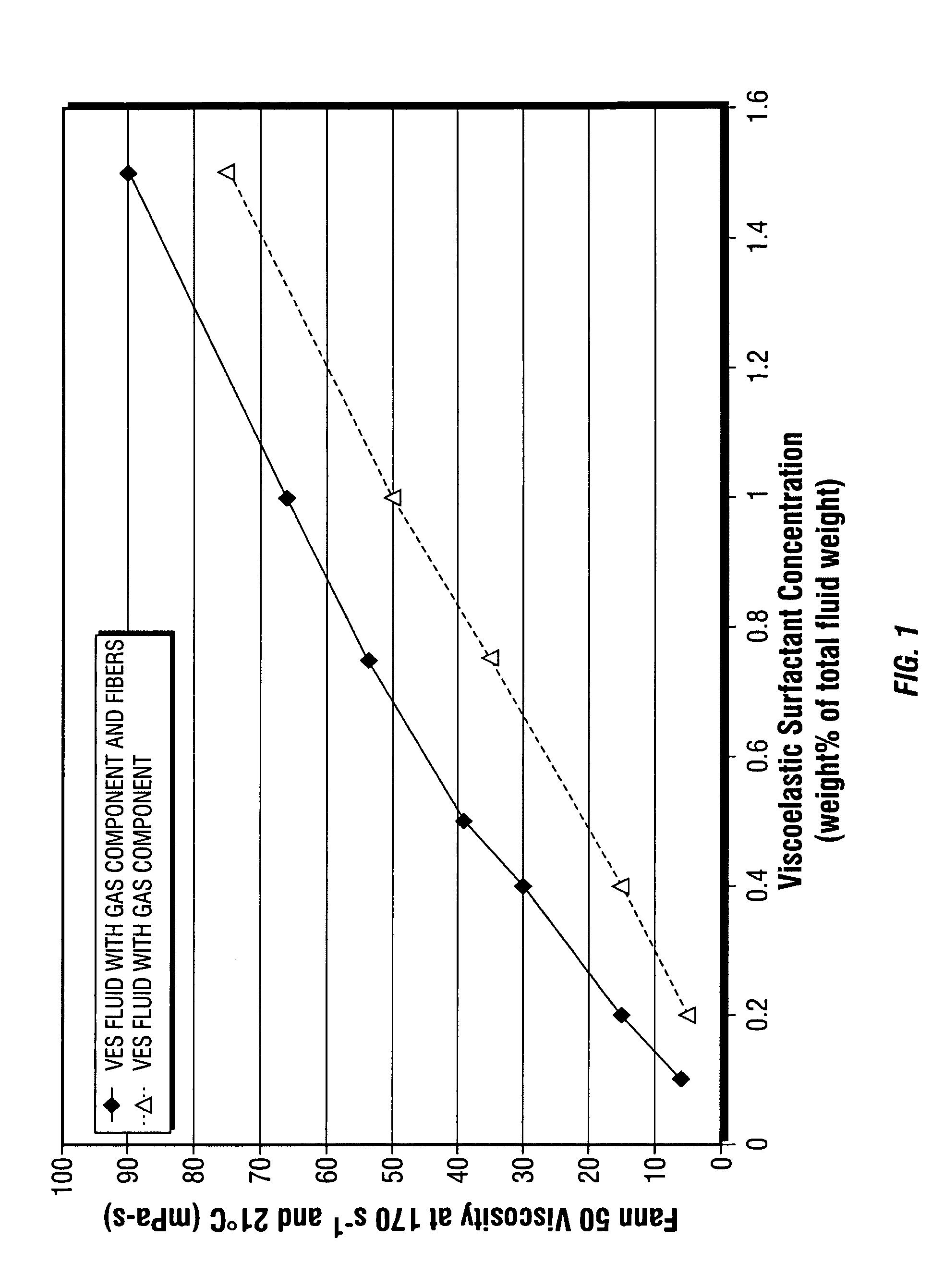Fiber laden energized fluids and methods of use
a fiber-laden, energized fluid technology, applied in fluid removal, chemistry apparatus and processes, borehole/well accessories, etc., can solve the problems of increasing resource and material requirements, poor proppant placement, and increasing polymer damage to the formation, and achieve good proppant suspension and transport properties, excellent gas phase stability
- Summary
- Abstract
- Description
- Claims
- Application Information
AI Technical Summary
Benefits of technology
Problems solved by technology
Method used
Image
Examples
examples
Viscoelastic Surfactant (VES) Fluid Example
[0042]A viscoelastic surfactant (VES) fluid example was prepared in a 1 liter warring blender, by mixing the following ingredients:
[0043]
IngredientWeight %Propane-1,2-diol13.4Propan-2-ol20.4Water5.1Erucyl bis-(2-Hydroxyethyl) Methyl Ammonium Chloride61.1
[0044]The resultant VES fluid was then used to prepare examples of aqueous viscoelastic fluids as set forth below.
examples a through l
VES Fluids Containing a Gas Component With and Without Fibers
[0045]The following examples, A through L, were prepared individually using a Waring blender. Ingredients added by weight percentage were weighed and added to the blender, and thoroughly mixed. Examples A through G contained fibers. Examples H through L did not contain fibers. 30 quality air was then introduced into the fluid to form a gas component by whipping the fluid / air mixture in the Waring blender. The volumes of gas component and fluid were subsequently measured in a graduated cylinder to determine the volume ratio of gas to fluid. Fann 50 viscosity was measured in each example at 170 s−1 and 21° C.
[0046]
Examples of VES Fluids Containing Fibers and a Gas Component(% amounts in wt % of total fluid wt %)ExampleExampleExampleExampleExampleExampleExampleABCDEFGWater97.4%97.3% 97.1%97.0%96.75%96.5%96.0%VES fluid 0.1% 0.2% 0.4% 0.5% 0.75% 1.0% 1.5%exampleAmmonium 1.5% 1.5% 1.5% 1.5% 1.5% 1.5% 1.5%Nitrate6.4 mm 1.0% 1.0% ...
examples m
and N
Proppant Containing VES Fluids
[0048]A benefit of adding fibers to viscoelastic fluids containing a gas component and proppant is significant extension of proppant settling time. To illustrate this benefit, the Examples M and N were prepared and evaluated.
[0049]In a Waring blender, 1% by weight of the viscoelastic surfactant fluid example above was mixed with 1.5% by weight ammonium nitrate and 97.5% by weight water. 30 quality air was then introduced into the fluid to form a gas component by whipping the fluid / air mixture in the Waring blender. The resultant fluid had a measured viscosity of 51 mPa·s at 170 s—1 and 21° C. Sand, as a proppant, was added to the gas containing fluid in the amount of 0.24 kg per liter of fluid, thus generating Example M. The foam half-life (to test gas phase stability) and proppant settling time were evaluated. The foam half-life was determined by the tests as set forth in U.S. Pat. No. 4,108,782, columns 5 and 6, under the headings “Initial Foam V...
PUM
 Login to View More
Login to View More Abstract
Description
Claims
Application Information
 Login to View More
Login to View More - R&D
- Intellectual Property
- Life Sciences
- Materials
- Tech Scout
- Unparalleled Data Quality
- Higher Quality Content
- 60% Fewer Hallucinations
Browse by: Latest US Patents, China's latest patents, Technical Efficacy Thesaurus, Application Domain, Technology Topic, Popular Technical Reports.
© 2025 PatSnap. All rights reserved.Legal|Privacy policy|Modern Slavery Act Transparency Statement|Sitemap|About US| Contact US: help@patsnap.com


